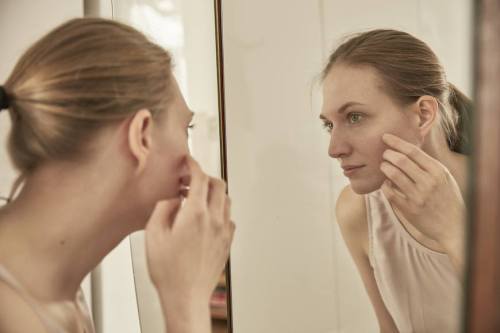This is the up-close-and-personal truth about what it’s like to get a skin check
Contemplating what skin cancer looks like, I went to a dermatologist for my first-ever skin check. Here's what the expereince was like.

My friends and I have a running joke that between the months of June and October, we stay far, far away from the dermatologist’s office. Because here’s the truth: Despite being a beauty editor who knows best sun-care practices by heart, I love the beach…and the pool. And while my habits have changed, for sure (I slather on SPF 70 every two hours and park it in the shade under an umbrella), I wasn’t as stringent with sun safety as a teen. But, lately I’ve been pondering the question: What does skin cancer look like anyways? So, I finally made an appointment with my dermatologist for my first-ever skin check to make sure the answer wasn’t lurking somewhere on my body.
I could make up a laundry list of reasons as to why I’d avoided getting one, but considering that my profession requires me to talk to dermatologists daily, there really isn’t any excuse. Given years of bad habits, I was a so worried about what a doctor might find that I simply avoided going altogether. Irresponsible, yes, but true nonetheless.
But this summer, two years after I lost my dad to a different type of cancer, a raised, black mole popped up under my arm that I couldn’t ignore. So, I scheduled my first ever skin-check appointment with Ellen Marmur, MD, a New York City dermatologist and founder of Marmur Medical. Her office on the Upper East Side was incredibly comfortable, and she did everything she could to help me chill out, but I was still really nervous.
Here’s what happens when you get a skin check, you strip down to your skivvies and a gown and a dermatologist literally goes over every inch of skin from head to toe. “For some people, every mole on their body looks so scary, but that’s just they’re signature mole,” she explained. Some can be tan, red, or brown in color, and some moles grow hairs out of them. “What we’re really looking for and what you should look for is the ugly duckling—the one that stands out.”
She began with my scalp, having me flip my head up and down so that she could take photos of anything that looked suspicious. Then, she worked her way down my body, using a magnifying tool to give her a closer look at the details and patterns of my spots. Once every inch had been skimmed over, including the bottoms of my feet, we had a chat.
This Parisian Skincare Brand Is Launching in the United States for the First Time—Here’s What a Derm Wants You to Know

We’re Calling It: Cleansing Balms Are the Face Wash of the Future—Here Are 3 to Add to Your Cart

This Is the One Product That Scarlett Johansson Always Keeps in Her Purse and on Her Bedside Table

Dr. Marmur asked me about a few of the larger spots on my body—one on my leg, one on the side of my boob, and the one under my arm—but after 15 minutes, she confirmed that everything appeared to be A-OK. She noted that while my moles were all good, for now, I should continue to watch them, and come back next year to make sure they haven’t changed.
“Delayed diagnosis is the number one killer for skin cancer,” she told me, as I silently thanked the universe that we weren’t having a very different conversation. “And often it’s someone your age who hasn’t really seen anyone—so if you’re a first time patient, there’s often a four month delay just to get an appointment.”
The American Academy of Dermatology recommends that adults get checked by a dermatologist at least once a year, in addition to also taking the time to regularly check their own skin. “Know your spots,” says Dr. Marmur. “Doing a full skin check on yourself once a month or so, your brain memorizes more than you’d think, so your visual brain is going to be like, ‘Oh yeah this is my pattern.’ And when a spot that you’ve had starts to change, you’ll have a Spidey sense—there will be something about it that bugs you.”
What you want to look out for, she explains, is any major changes in these dark marks. “You don’t want them to spread out, you don’t want them to have little amoeba-like pseudo pods starfish-y looking things, you don’t want them to like bleed when you shave your legs—you don’t want them to stand out in your mind,” she says. “So knowing your own skin is a free thing you can do.”
In addition to getting up close and personal with your beauty marks, protecting yourself—as we all know—is the first step in prevention. “It’s not all or nothing,” Dr. Marmur tells me, reassuring me that I can undo some of the damage I did to my skin in my younger years by “being good” in my 20s, 30s and 40s. “You can go hiking to the top of the world, you can be in the sun, but you shouldn’t be trying to get sun—you should try to protect your skin.”
For what it’s worth, I can’t wait to see her again next fall, and will be chillin’ under an umbrella in SPF 70 until then.
Checking your skin is extra-important, so here’s our complete guide on how to do it the right way. And while we’re at it, here are 9 of the best face sunscreens to keep you—and your moles—protected.
Sign Up for Our Daily Newsletter
Get all the latest in wellness, trends, food, fitness, beauty, and more delivered right to your inbox.
Got it, you've been added to our email list.







